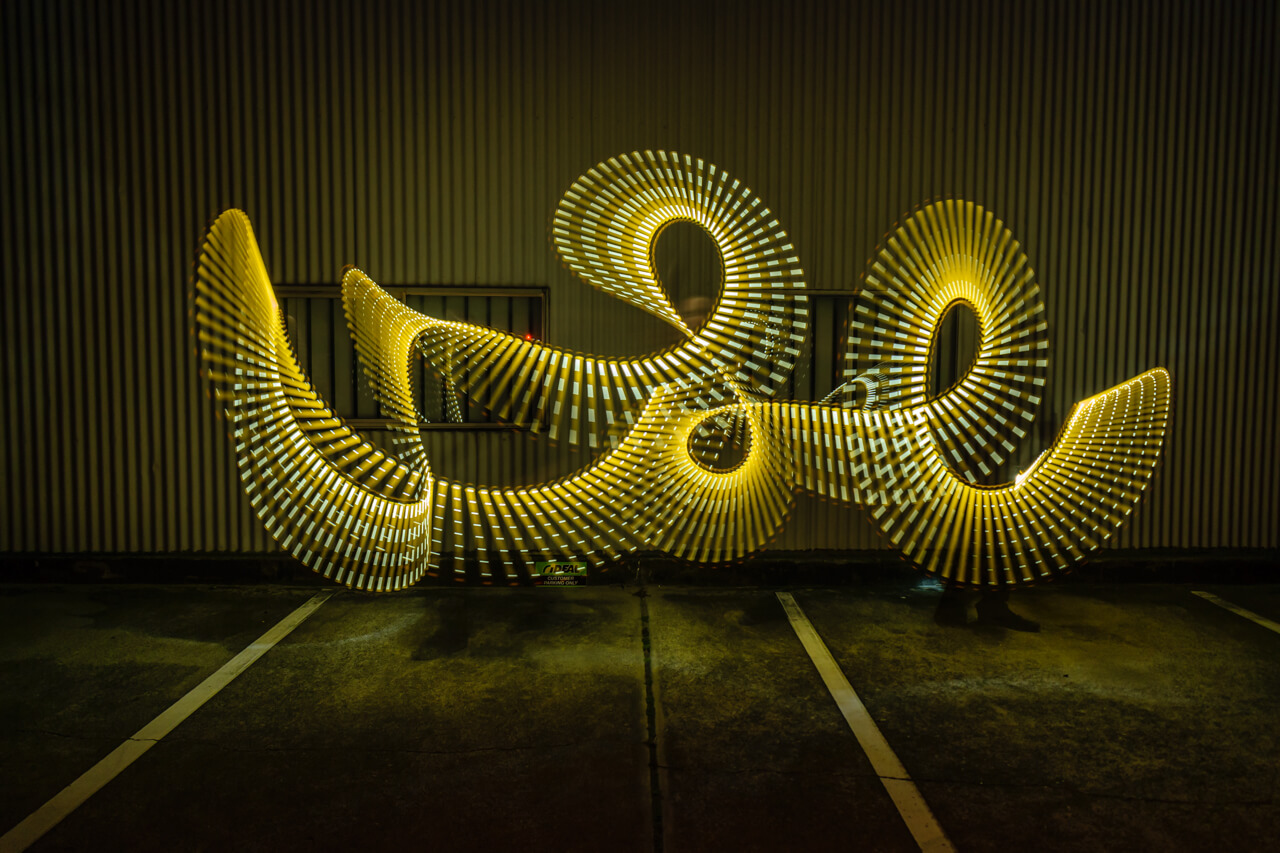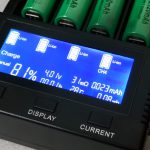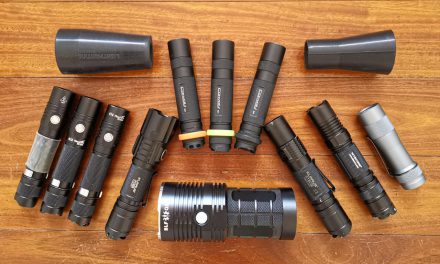
Flashlight Review: TLF/BLF FW3A

Update 15/09/2019 – review updated to mention FW1A and Anduril updates.
Introduction
The TLF/BLF FW3A is a flashlight designed by flashlight enthusiasts, and manufactured by Lumintop, that has been in the works for a very long time. With high brightness, and multiple strobe modes with adjustable strobe frequency, it has great potential for light painters. Let’s see how it performs.
Disclaimer
The TLF/BLF FW3A was purchased by myself from Neals Gadgets. Product Link. 20% off code: SKFW3A
Construction
The TFL/BLF FW3A is a reasonably priced, compact EDC flashlight that uses an 18650 rechargeable li-ion battery. It is one of the smallest 18650 battery flashlights in existence, and has an attractive shape with a slightly larger head (25.5mm diameter) than battery tube, plus an integrated clip. The light will fit into light painting connectors from Light Painting Brushes, Light Painting Paradise, and Light Painting Tubes. The instructions are also very good, and in both English and German.
The optics in the reviewed version are (genuine) triple Cree XP-L HI emitters, with neutral white 3D tint. Other tint and emitter options are available. The optics are frosted Carclo 10511 lenses. This is a very powerful flashlight for its size, reaching up to approximately 2800 lumens from a 1×7135+8×7135+FET three channel driver with Andúril firmware. The FW3A will only work with unprotected, flat top, 18650 li-ion batteries. For max output use high drain batteries such as Sony VTC5A/6 or Samsung 30Q. For more conservative turbo output (<2000 lumens), or for those not intending on using this light above the default ramp ceiling of 760 lumens, it is recommended to use higher capacity Panasonic NCR18650GA, LG MJ1, or Samsung 35E batteries. This light is only recommended for people who understand the dangers of using unprotected li-ion batteries.
There is a single tail e-switch user interface, which will be explained in the next section. It needs to noted that it is recommended to unscrew the head to insert/remove batteries, as unscrewing the tail cap can result in the tail switch falling apart.

FW3A Triple Emitter
User Interface
This light uses the highly flexible (and complex) Andúril firmware, and is one of the first implemented uses of this firmware on a flashlight that is suitable for attaching to light painting tools. A picture tells a thousand words, so below is a photo of how the firmware works. If you can fully understand it, you might get a degree! However for basic use it is fairly easy to remember. Users need to be careful to not get too click happy, as it is easy to accidentally change settings.

FW3A Andúril UI

FW3A Andúril UI
Major features of the Andúril firmware are:
- ‘Party strobe’ with (approx.) 1.3ms on time/adjustable off time. Adjustable frequency between approx. 3.5 and 112 Hz (default 24Hz). Great for mid-air “freezing” effect.
- ‘Tactical strobe’, 33% on/67% off time. Adjustable frequency between 2.5 and 80Hz (default 10Hz).
- Memory mode for last used strobe setting.
- Lightning storm effect, bike flash mode (1Hz cycle), candle flicker mode, and beacon modes.
- Adjustable ramping mode (you can change the min, max, and stepped/smooth ramping settings).
- Direct(ish) access to ramp min, memorised, and ramp max settings.
- Momentary mode – updated version of Anduril now works for strobe!
- Muggle mode (240lm max), mechanical and electronic lockout, battery check, and thermal configuration settings for safety.
- Low voltage protection at 2.9V.
I really like the ability to adjust the strobe frequency, and that the last strobe mode is memorised. Click-hold decreases the strobe frequency, and hold increases the strobe frequency. The strobes run at the maximum regulated output at around 760 lumens. In the original FW3A, to turn on the strobes from off requires a click-click-hold, which makes it difficult to turn on mid-light painting scene. However the newer version of Anduril allows strobe to accessed via Momentary functionality. There is also no ability to change between constant and strobe, or back again on the fly. However, you can ramp the strobe frequency up or down during an exposure, which is pretty cool!
The test images below show light trails from the ‘party’ and ‘tactical’ strobes at maximum and minimum frequency. (I was hoping for a better backdrop, but at my planned industrial location, someone left the lights on). The ‘party strobe’ with its 1.3ms on time is great for freezing the moving light painting tool mid-air. This has a lot of creative potential for light painting, particularly with light blades. Due to the very fast flash, this strobe is not as bright as would be expected for 760 lumens. The ‘tactical strobe’ is more conventional with the light being on for 33% of each strobe cycle.

FW3A Party Strobe – Maximum Frequency

FW3A Party Strobe – Minimum Frequency – note how the moving lightflute is “frozen” in mid-air

FW3A Tactical Strobe – Maximum Frequency

FW3A Tactical Strobe – Minimum Frequency
Beam and output
The FW3A uses a triple emitter setup. The reviewed light uses Cree XP-L HI emitters with neutral white 3D tint (similar to the BLF Q8). Due to the triple emitter design, the light uses TIR optics, in this case frosted Carclo 10511 optics. This creates a relatively narrow (30 degree), but diffuse floody beam. The beam profile and triple emitters mean that this light is better for illuminating fiber optic brushes and light blades than longer tools (rods, swords, tubes, and lightflutes). It is still useable with longer tools, but there will be noticeable brightness gradient along the tube. If you want a throwier beam, then you would have to mod the optics to a clear 10507, which will provide more peak beam intensity per lumen. The Cree XP-L HI is available in cool (1A), neutral (3D), and warm white (7A) tints. The Luminus SST-20 option is expected to be available in warm/neutral 4000k high CRI version, and will have less lumens, slightly more peak beam intensity, and a possible hint of green.
Due to having a FET driver, the FW3A can reach up to approx. 2800 lumens with high current 18650 batteries. However, as the light is compact, it is no surprise that the light heats up extremely quickly, and the output steps down to around 750 lumens after just 30 seconds. After around 10 minutes, the light will be running at between 300 and 400 lumens. The strobe modes run at maximum regulated output, which is approx. 760 lumens, and can be sustained for a few minutes before step down.
Pulse Width Modulation (PWM) is used at lower brightness levels, but thankfully the frequency is very high at 15kHz, so is not noticeable. The frosted optics mean that the colour temperature is the same across the beam – no fried egg beams here! The colour rendering index (CRI) is around 70CRI, good enough for most purposes.

FW3A Beam Profile
Conclusion
Things I liked:
- Adjustable strobe frequency, with memory.
- Impressive range of strobe effects from ‘party’ and ‘tactical’ strobe modes.
- Lots of different effect and flashy modes.
- Momentary mode with adjustable brightness or strobe.
- Very bright turbo mode for a 18650 light.
- Basic use is fairly easy to master.
- No visible PWM.
- Choice of tints (cool 1A, neutral 3D, or warm 7A white) and emitters (Cree XP-L HI, and Luminus SST-20).
- Clip included.
- Good manual in English and German.
- Mechanical and electronic lock out, plus low voltage protection.
Things I didn’t like:
- Floody beam profile is not optimal for use with longer light painting tools..
- Unable to change from constant to strobe on the fly.
- Tail switch can fall apart easily – unscrew head to insert/remove battery.
- No remote pressure switch.
- Very complex user interface to fully master.
- Only accepts flat top unprotected 18650 li-ion batteries.
For a compact general purpose flashlight for flashlight enthusiasts, the FW3A is excellent. For light painting photography it has good and bad points. Excellent strobe effects with adjustable frequency (I love the ‘party strobe’), momentary functionality (on constant output), and a choice of tints are major benefits. Unfortunately, it is tricky to turn on the strobe mid-light painting scene, which will limit the use cases of this light in certain light painting scenes . The beam profile is not the best for longer light painting tools. To use this light to its full potential requires a technical mind, ability to read instructions, and awareness of li-ion safety. Despite these limitations, this is the only commercial flashlight suitable for light painting (that I’m aware of) with an adjustable strobe frequency, and is thus highly recommended due to the amazing creative possibilities.
FW3A Product Link. 20% off code: SKFW3A
Update: The FW1A has now been released, which has a single central emitter, much better for illuminating light painting tools. Choose Cree XP-L HI 1A or 3D emitter options. FW1A Product Link.

TLF/BLF FW3A Flashlight















Hi Stephen! Thanks for this updated information. The new revamped strobe mode is wonderful!
How can we be sure to get the newer Andúril firmware when purchasing the FW3A?
Thank you and have a nice day 😉
If purchased through Neals Gadgets I think all new lights should have the updated version (and it has probably been that way for a few months as the old stock had sold out). Other vendors might have old stock. I would now recommend the new FW1A over the FW3A.
Thanks Stephen,
Now I can see why the new FW1A is more interesting for a lightpainter. 🙂
The toughest part is to choose the tint of the emitter… I love the warmer tint (7A) which gives an incandescent look, but a neutral white (3D) would be more versatile…
I guess I’ll wait for the 7A to be available. Do you have any clue on that?
Have a nice day,
Cheers
Hi, I’m sure the 7A will be available soon. 1A and 3D are generally the best option for use with light painting tools. I prefer to use 7A for illuminating scenes, and to contrast against cooler light sources.